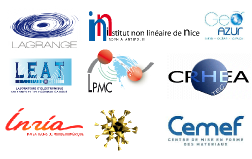Programme
09:30 Ouverture
09:35 - 10:20 Bruno Cessac - De la rétine à la physique statistique +/-
De la rétine à la physique statistique
10:20 - 10:45 Pause café
10:45 - 11:30 Jesús Zúñiga-Pérez - Room-Temperature Polaritonics Based In ZnO +/-
Room-Temperature Polaritonics Based In ZnO
Semiconductor planar microcavities operating in the strong-coupling regime, i.e. optical resonators in which the eigenmodes of the system are no longer purely excitonic nor purely photonic but a mixture them, have seen a rapid development in the last years especially since the demonstration of polariton Bose-Einstein condensation. The numerous and exciting discoveries that have followed, including superfluidity and topological defects generation, have been possible thanks to a mature fabrication technology of distributed Bragg reflectors (DBRs) and semiconductor heterostructures, mainly based in GaAs and CdTe. This evolution has finally led to polariton manipulation. However, all these experiments were carried out at low temperatures because, even if the strong-coupling regime can be kept up to room-temperature in those systems, their limited exciton stability at high temperatures and large particle density precluded condensation at room-temperature (RT).
If polariton condensation wants to be obtained at high temperature, i.e. RT or above, materials with large oscillator strengths and large exciton binding energies must be employed. This is the reason why so much attention has been paid lately to organic semiconductors, GaN and ZnO.
In this talk, and after a brief overview of room-temperature polaritonics, we will describe the development of ZnO-based microcavities. It will be shown that two basic types of planar microcavities can be conceived containing either two dielectric DBRs or a combination of an epitaxial and a dielectric DBR. Such kind of cavities can display RT polariton condensation (i.e. the polariton lasing transition), as accompanied by: an increase of the output intensity by more than two orders of magnitude, a reduction of the emission linewidth below that of the bare-cavity mode, and a relatively small blueshift of the lower polariton branch (less than 10% of the Rabi splitting). This last feature is especially important since it assures that the lasing transition occurs within the strong-coupling regime. Next, we will illustrate how the matter/light content of polaritons can determine their relaxation kinetics from the exciton reservoir down to the bottom of the lower polariton branch, where they can eventually condensate, as well as the physical properties of the associated condensates (in particular their propagation characteristics).
Finally, we will discuss prospective applications of these cavities as well as the possibility of integrating them into more complex platforms combining several functionalities.
- 11:30 - 12:15 Frédéric Patras - Champs moyens et méthodes PMCMC +/-
Champs moyens et méthodes PMCMC.
12:15 - 13:45 Déjeuner
13:45 - 14:30 Agnese Seminara - The physics of motility and cooperation in biological systems +/-
The physics of motility and cooperation in biological systems
The evolution of living organisms is shaped by the physical environment where they live. Different species operate at different spatial and temporal scales and to survive they have to adequately probe and respond to their surroundings. Microbes live in a world dominated by viscosity, imposing severe constraints on motility. I will focus on the biomechanics of collective motility in two systems of microorganisms where cells cooperate to elude these physical constraints: bacterial biofilms and fungal spore dispersal. Combining high speed imaging and fluorescence microscopy with theoretical tools borrowed from the continuum and statistical mechanics of complex systems, I will discuss how cells manipulate their physical environment as a survival strategy, and the threats to cooperation imposed by potential cheaters. Organisms living in a fluctuating physical environment must face uncertainty, which is a fundamental driver of biological behavior. I will conclude by discussing the physical constraints ensuing from stochasticity in the fluid dynamics of airborne dispersal.
]]
- 14:30 - 15:15 Matthieu Bellec - A microwave realization of artificial graphene +/-
A microwave realization of artificial graphene
15:15 - 15:45 Pause café
15:45 - 16:30 Mathias Albert - Temps d'attente en mécanique quantique: un clin d'oeil au chaos quantique +/-
Temps d'attente en mécanique quantique: un clin d'oeil au chaos quantique
Le transport à l'échelle mésoscopique est essentiellement stochastique à cause de la nature quantique des porteurs de charge. Ces fluctuations fondamentales, au lieu d'être parasites sont au contraire une source d'informations comme le suggérait Rolf Landauer dans sa célèbre citation "the noise is the signal". Ainsi, de nombreux outils statistiques, comme le bruit ou la statistique de comptage, ont été développés lors des 20 dernières années pour comprendre la physique des conducteurs cohérents.
Récemment, le concept de temps d'attente entre différentes détections a été introduit dans ce domaine et s'est avéré être un outil de choix pour étudier la physique aux temps courts, un peu dans le même esprit que la distribution des niveaux d'énergie voisins s'est avérée très informative dans l'étude des systèmes quantiques complexes.
Au cours de cet exposé, je présenterai un aperçu de cette physique dans le domaine du transport électronique avec des ouvertures vers les atomes ultra froids. J'exposerai en particulier le cas d'un seul canal quantique parfaitement conducteur où la théorie des matrices aléatoires apparaît de façon inattendue.
